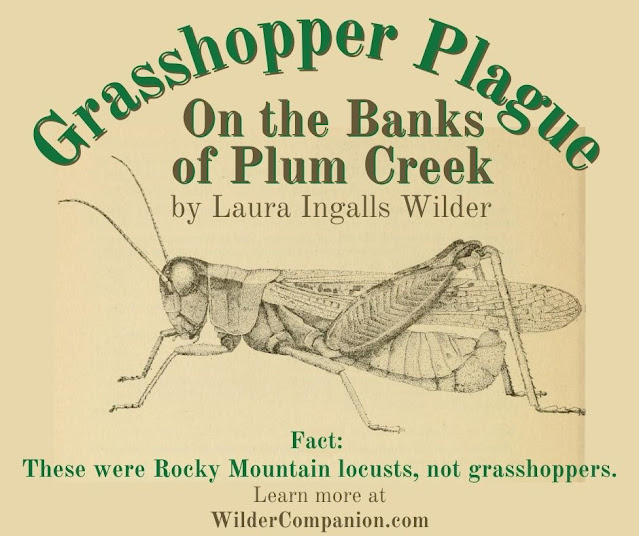Have you ever wondered if the grasshoppers described in Laura Ingalls Wilder's On the Banks of Plum Creek were exaggerated? It seemed like a good story, but could it be real? Did Laura Ingalls Wilder describe these insects accurately?
Wilder introduced the grasshoppers in the chapter titled "The Glittering Cloud."
Something seemed to dim the sunshine. Laura rubbed her eyes and looked again. The sunshine really was dim. It grew dimmer until there was no sunshine...The light was queer. It was not like the changed light before a storm. Laura was frightened, she did not know why...A cloud was over the sun. It was not like any cloud they had ever seen before. It was a cloud of something like snowflakes, but they were larger than snowflakes, and thin and glittering. Light shone through each flickering particle...Plunk!"
Later in the chapter titled "Grasshoppers Walking" Wilder wrote,
All across the dooryard the grasshoppers were walking shoulder to shoulder and end to end, so crowded that the ground seemed to be moving. Not a single one hopped. Not one turned its head. As fast as they could go, they were all walking west."
Please note: If you are reading this blog post in an email, you may not be able to see all images or click on links unless you go to the blog by clicking the title of today's blog post.
Like many others, I wondered (as a child and adult) if the grasshopper accounts were accurate. Now that I'm an adult I seek answers to my questions. As a professional nonfiction author, I go beyond basic research to dig deep into solid resources. I get hands-on when possible and reach out to experts frequently. (Yes, I sometimes spend weeks researching for just a few paragraphs.)
While writing The Laura Ingalls Wilder Companion: A Chapter-by-Chapter Guide (affiliate link), one of my favorite resources about the grasshoppers featured in On the Banks of Plum Creek was a book titled Locust: The Devastating Rise and Mysterious Disappearance of the Insect that Shaped the American Frontier by Jeffrey A. Lockwood.
In fact, I contacted Jeff as an expert reader for the feature about the grasshoppers in my own book. (I write about science and history. But I'm not a scientist or a historian. So I consult with experts even if it's just for a few paragraphs (like this book or one sentence like other books! I worked with many experts as well as a sensitivity reader when writing The Laura Ingalls Wilder Companion. Some were Almanzo and Laura Ingalls Wilder experts. Others were topical experts.)
Laura Ingalls Wilder's account of the grasshopper plague agreed with other first-hand accounts. She did not exaggerate. However, these despised insects that devoured everything in sight were not grasshoppers. They were locusts. Specifically, Melanoplus spretus, the Rocky Mountain locust.
In normal populations, grasshoppers and locusts are quite similar. When locusts become overcrowded, they develop long wings and migrate in huge swarms. (Notice the physical similarities and differences in the image to the left.) It's these locust swarms that cause incredible damage. Grasshoppers also eat plants, but they won't wipe out entire crops in a region or swarm by the millions.
Do you wonder why the farmers on the Great Plains aren't dealing with the Rocky Mountain locust today? If you read my book, you already know. The Rocky Mountain locust went extinct! The last recorded sighting was in 1902. Scientists generally agree the Rocky Mountain locust lost its habitat as settlers moved west which led to the its extinction.
Other species of locusts still torment people around the world and on every continent except Antarctica. However, no swarms compare in size to the Rocky Mountain locusts that devastated the American frontier in the 1800s.
If you're interested in going back in history like Ma did in chapter 27 of On the Banks of Plum Creek, you can read the biblical account about the plague of locusts in Exodus, chapter 10 of the Bible.
I wrote about the Little House grasshopper plague on this blog before. Want more information about "grasshoppers" in the Little House books? In addition to the book Locust mentioned above, the Encyclopedia of Life has some facts for you.
I'd also like to invite you to participate in an online book discussion. The Laura Ingalls Wilder Museum of Walnut Grove, Minnesota is sponsoring an On the Banks of Plum Creek discussion with authors Cindy Wilson, Dan Peterson, and me (Annette Whipple). Learn more about this book discussion!
In my book, The Laura Ingalls Wilder Companion: A Chapter-by-Chapter Guide, I explore many Little House topics that readers still wonder about today. I loved researching this book as well as creating 75 "Live Like Laura" activities.
Happy Trails!
~ Annette
Annette Whipple is a nonfiction children's author. Learn more about her books and presentations at www.AnnetteWhipple.com.












No comments